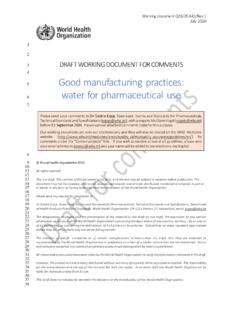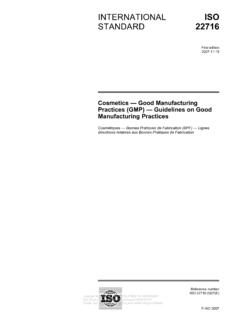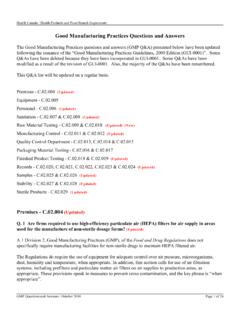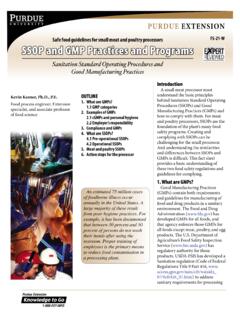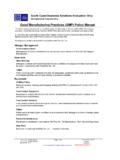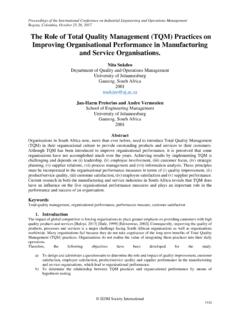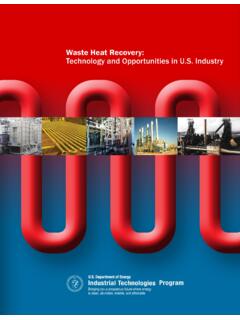Transcription of WHO good manufacturing practices for biological products
1 93 Annex 2 WHO good manufacturing practices for biological productsReplacement of Annex 1 of WHO Technical Report Series, No. 8221. Introduction 962. Scope 963. Terminology 1004. Principles and general considerations 1045. Pharmaceutical quality system and quality risk management 1066. Personnel 1067. Starting materials 1078. Seed lots and cell banks 1099. Premises and equipment 11110. Containment 11311. Clean rooms 11512. Production 11613. Campaign production 11814. Labelling 11915. Validation 11916. Quality control 12117. Documentation (batch processing records) 12218. Use of animals 12319. Authors and acknowledgements 12520. References 12794 WHO Technical Report Series No.
2 999, 2016 WHO Expert Committee on biological Standardization Sixty-sixth reportGuidelines published by WHO are intended to be scientific and advisory in nature. Each of the following sections constitutes guidance for national regulatory authorities (NRAs) and for manufacturers of biological products . If an NRA so desires, these WHO Guidelines may be adopted as definitive national requirements, or modifications may be justified and made by the 295 AbbreviationsAEFI adverse event following immunizationATMP advanced therapy medicinal productBCG bacille Calmette Gu rinGMP good manufacturing practice(s)HEPA high-efficiency particulate airHVAC heating, ventilation and air conditioningIgE immunoglobulin EmAb monoclonal antibodyMCB master cell bankMSL master seed lotMVS master virus seedNRA national regulatory authorityPDL population doubling levelPQR product quality reviewPQS pharmaceutical quality systemQRM quality risk managementrDNA recombinant DNASPF specific pathogen freeTSE transmissible spongiform encephalopathyWCB working cell bankWSL working seed lotWVS working virus seed96 WHO Technical Report Series No.
3 999, 2016 WHO Expert Committee on biological Standardization Sixty-sixth report1. IntroductionBiological products can be defined according to their source material and method of manufacture. The source materials and methods employed in the manufacture of biological products for human use therefore represent critical factors in shaping their appropriate regulatory control. biological products are derived from cells, tissues or microorganisms and reflect the inherent variability characteristic of living materials. The active substances in biological products are often too complex to be fully characterized by utilizing physicochemical testing methods alone and may show a marked heterogeneity from one preparation and/or batch to the next.
4 Consequently, special considerations are needed when manufacturing biological products in order to maintain consistency in product manufacturing practices (GMP) for biological products were first published by WHO in 1992 (1). This current revision reflects subsequent developments that have taken place in science and technology, and in the application of risk-based approaches to GMP (2 14). The content of this document should be considered complementary to the general recommendations set out in the current WHO good manufacturing practices for pharmaceutical products : main principles (2) and in other WHO documents related specifically to the production and control of biological document is intended to serve as a basis for establishing national guidelines for GMP for biological products .
5 If a national regulatory authority (NRA) so desires, the guidance provided may be adopted as definitive national requirements, or modifications may be justified and made by the NRA in light of the risk benefit balance and legal considerations in each authority. In such cases, it is recommended that any modification to the principles and technical specifications set out below should be made only on the condition that the modifications ensure product quality, safety and efficacy that are at least equivalent to that recommended in this ScopeThe guidance provided in this document applies to the manufacture, control and testing of biological products for human use from starting materials and preparations (including seed lots, cell banks and intermediates) to the finished procedures within the scope of this document include: growth of strains of microorganisms and eukaryotic cells.
6 Extraction of substances from biological tissues, including human, animal and plant tissues, and fungi;Annex 297 recombinant DNA (rDNA) techniques; hybridoma techniques; propagation of microorganisms in embryos or products of biological origin manufactured by these procedures include allergens, antigens, vaccines, certain hormones, cytokines, monoclonal antibodies (mAbs), enzymes, animal immune sera, products of fermentation (including products derived from rDNA), biological diagnostic reagents for in vivo use and advanced therapy medicinal products (ATMPs) used for example in gene therapy and cell human whole blood, blood components and plasma-derived products for therapeutic use separate comprehensive WHO guidance is available and should be followed (12, 15).
7 In some countries certain small-molecule medicinal products (for example, antibiotics) are not defined as biological products . Nevertheless, where the manufacturing procedures described in this document are used then the guidance provided may be preparation of investigational medicinal products for use in clinical trials should follow the basic principles of GMP set out in these and other WHO GMP guidelines (2, 16) as appropriate. However, certain other requirements (such as process and analytical method validations) could be completed before marketing authorization (17 19).The current document does not provide detailed recommendations for specific classes of biological products (for example, vaccines).
8 Attention is therefore directed to other relevant WHO documents, and in particular to WHO recommendations to assure the quality, safety and efficacy of specific 1 illustrates the typical risk-based application of the current document (4, 7). It should be noted that this table is illustrative only and is not intended to describe the precise See: (accessed 4 November 2015).98 WHO Technical Report Series No. 999, 2016 WHO Expert Committee on biological Standardization Sixty-sixth reportTable 1 Scope of the current document (illustrative)Type and source of materialExample productsApplication of this document to steps in manufacture1. Animal or plant sources: non-transgenicHeparins, insulin, enzymes, proteins, allergen extract, ATMPs, animal immune seraCollection of plant, organ, tissue or fluidCutting, mixing and/or initial processingIsolation andpurificationFormulation and filling2.
9 Virus or bacteria/fermentation/cell cultureViral or bacterial vaccines, enzymes, proteinsEstablishment and maintenance of MCB, WCB, MSL/MVS, WSL/WVSCell culture and/or fermentationInactivation when applicable, isolation and purificationFormulation and filling3. Biotechnology fermentation/cell cultureRecombinant products , mAbs, allergens, vaccines, gene therapy (viral and non-viral vectors, plasmids)Establishment and maintenance of MCB, WCB, MSL, WSLCell culture and/or fermentationIsolation, purification and modificationFormulation and filling4. Animal sources: transgenicRecombinant proteins, ATMPsMaster and working transgenic bankCollection, cutting, mixing and/or initial processingIsolation, purification and modificationFormulation and filling5.
10 Plant sources: transgenicRecombinant proteins, vaccines, allergensMaster and working transgenic bankGrowing and/or harvestingInitial extraction,isolation, purification and modificationFormulation and fillingAnnex 299 Type and source of materialExample productsApplication of this document to steps in manufacture6. Human sourcesUrine-derived enzymes, hormonesCollection of fluidMixing and/or initial processingIsolation and purificationFormulation and filling7. Human and/or animal sourcesGene therapy: genetically modified cellsDonation,procurement and testing of starting tissue/cellsaVector manufacture and cell purificationand processingEx vivo geneticmodification of cells, establish MCB, WCB or cell stockFormulation and fillingSomatic cell therapyDonation, procurement and testing of starting tissue/cellsaEstablishing and maintaining MCB, WCB or cell stockCell isolation, culture purification and combination with non-cellular componentsFormulation, combination and fillingTissue-engineered productsDonation,procurement and testing of starting tissue/cellsaInitial processing,isolation and purification, establishing and maintaining MCB, WCB, primary cell stockCell isolation, culture.










